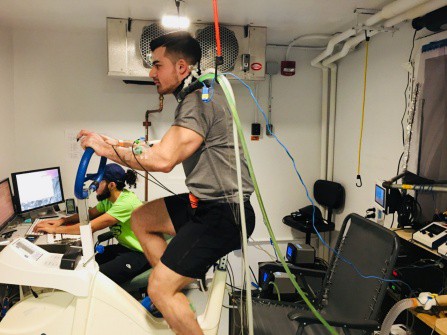New research from the University at Buffalo has, for the first time, identified differences between men and women in their preferences for maintaining comfort both while exercising and in recovery. The results could one day inform the development of new athletic apparel.
The human body has a variety of automatic mechanisms in place to respond to being too warm, including sweating and increased skin blood flow. But people also have voluntary ways of cooling themselves down. If you’re in a stuffy room, for example, you can remove your jacket.
Scientists refer to these voluntary actions as “thermal behavior.”
“This study is the first to highlight sex differences in thermal behavior,” said Nicole Vargas, a postdoctoral fellow in exercise and nutrition sciences in UB’s School of Public Health and Health Professions.
Vargas is the lead author on the study, published online in August ahead of a scheduled December print date in Medicine & Science in Sports & Exercise, the official journal of the American College of Sports Medicine.
The study took place in UB’s Center for Research and Education in Special Environments. Researchers had 10 men and 10 women in their early 20s exercise at low intensity — about 65 revolutions per minute — on a stationary bicycle for one hour while watching a nature documentary. Each participant was equipped with a custom-made device: a dual tubing system that was in direct contact with the back of their neck.
The basic model for this study harkened back to similar studies in thermal behavior done in the 1970s. Those, however, used the hand for cooling purposes. “The neck makes more sense, however, because it’s more sensitive perceptually, so it gave us a more sensitive measure of thermal behavior,” explained Zachary Schlader, the study’s senior author and an assistant professor of exercise and nutrition sciences at UB.
One set of tubing was perfused with 93.2 degrees Fahrenheit water. The other series of tubes contained -4 degree liquid, but the flow of this liquid was controlled by a valve. Participants were instructed to “thermally behave” — or open the valve, thereby releasing the flow of extremely cold liquid — any time they felt that their neck was uncomfortably warm while exercising.
New research from the University at Buffalo has, for the first time, identified differences between men and women in their preferences for maintaining comfort both while exercising and in recovery. The results could one day inform the development of new athletic apparel.
The human body has a variety of automatic mechanisms in place to respond to being too warm, including sweating and increased skin blood flow. But people also have voluntary ways of cooling themselves down. If you’re in a stuffy room, for example, you can remove your jacket.
Scientists refer to these voluntary actions as “thermal behavior.”
“This study is the first to highlight sex differences in thermal behavior,” said Nicole Vargas, a postdoctoral fellow in exercise and nutrition sciences in UB’s School of Public Health and Health Professions.
Vargas is the lead author on the study, published online in August ahead of a scheduled December print date in Medicine & Science in Sports & Exercise, the official journal of the American College of Sports Medicine.
The study took place in UB’s Center for Research and Education in Special Environments. Researchers had 10 men and 10 women in their early 20s exercise at low intensity — about 65 revolutions per minute — on a stationary bicycle for one hour while watching a nature documentary. Each participant was equipped with a custom-made device: a dual tubing system that was in direct contact with the back of their neck.
The basic model for this study harkened back to similar studies in thermal behavior done in the 1970s. Those, however, used the hand for cooling purposes. “The neck makes more sense, however, because it’s more sensitive perceptually, so it gave us a more sensitive measure of thermal behavior,” explained Zachary Schlader, the study’s senior author and an assistant professor of exercise and nutrition sciences at UB.
One set of tubing was perfused with 93.2 degrees Fahrenheit water. The other series of tubes contained -4 degree liquid, but the flow of this liquid was controlled by a valve. Participants were instructed to “thermally behave” — or open the valve, thereby releasing the flow of extremely cold liquid — any time they felt that their neck was uncomfortably warm while exercising.


